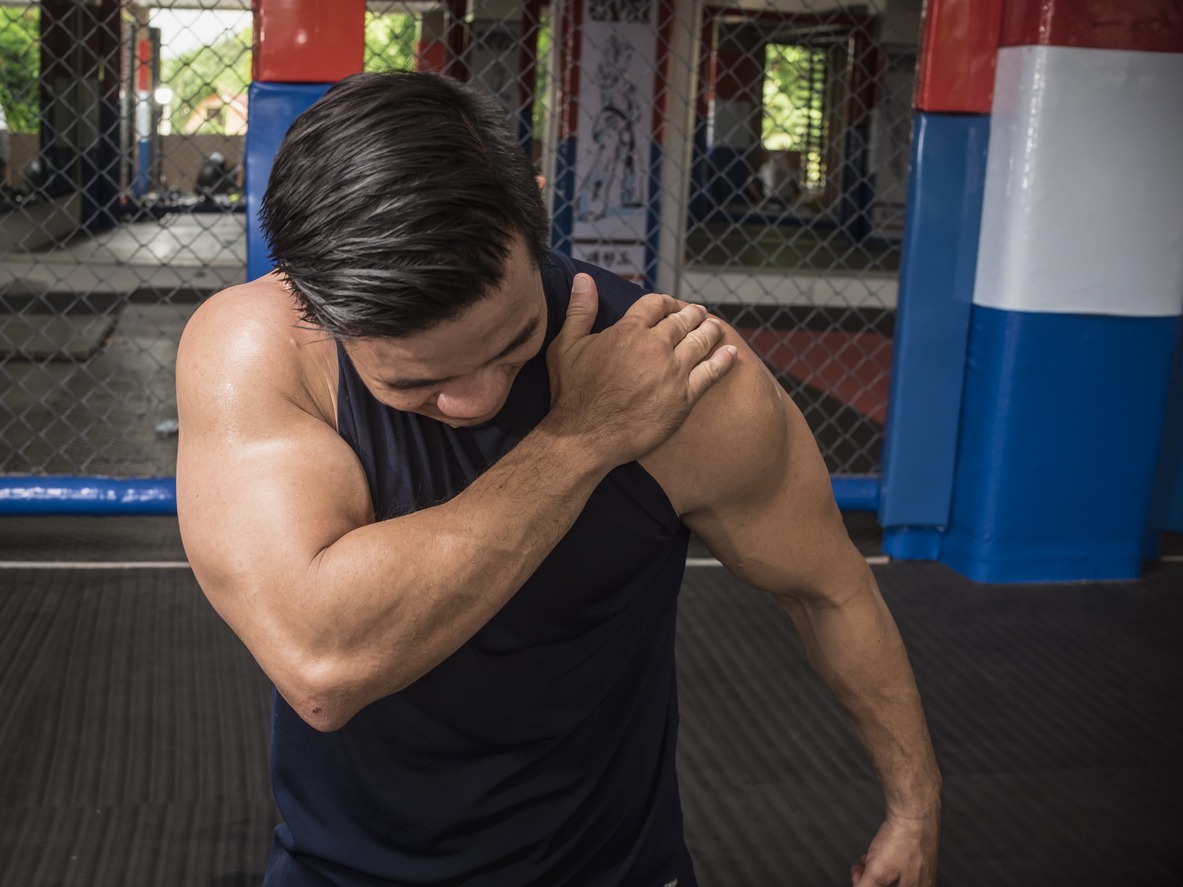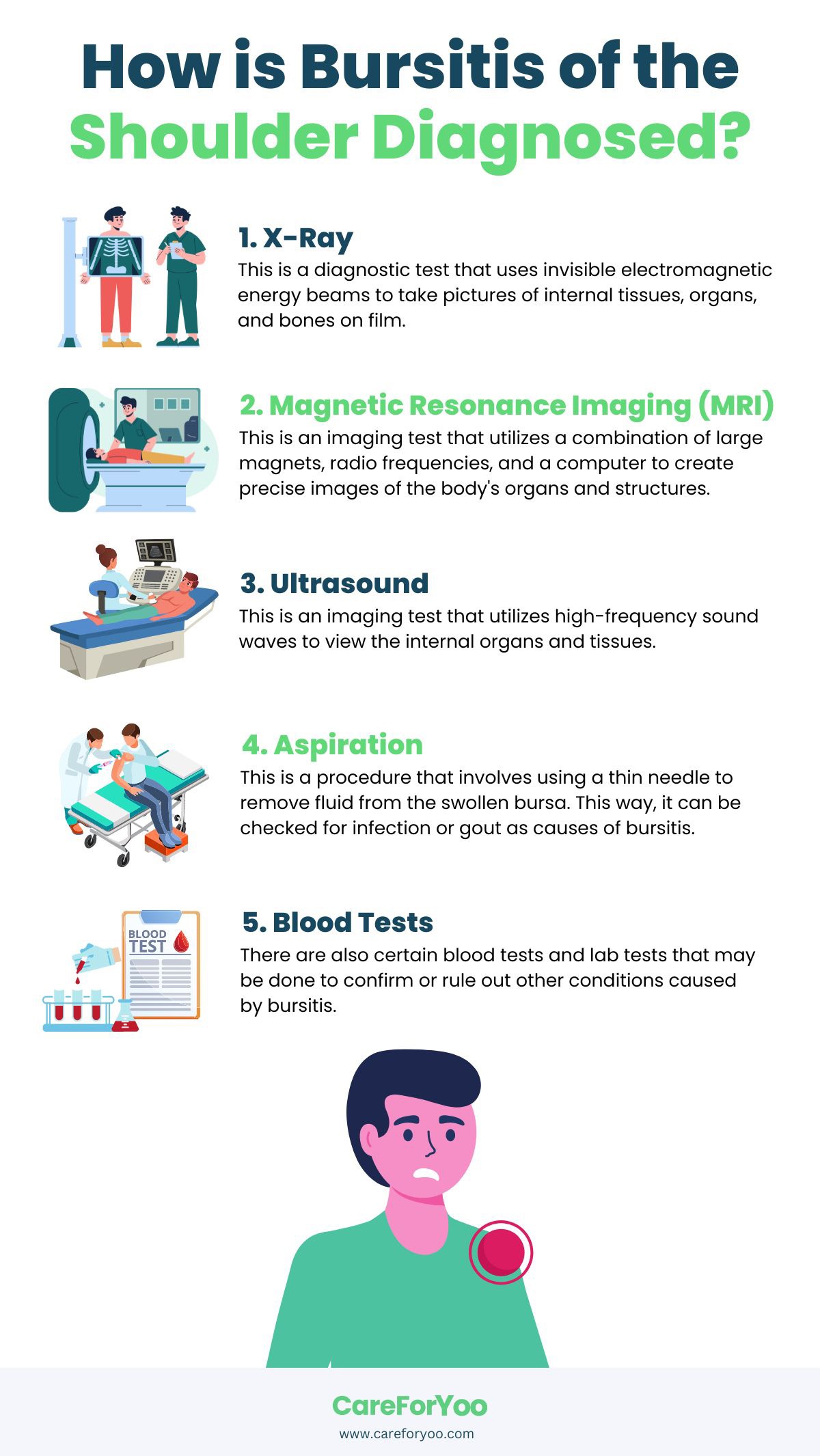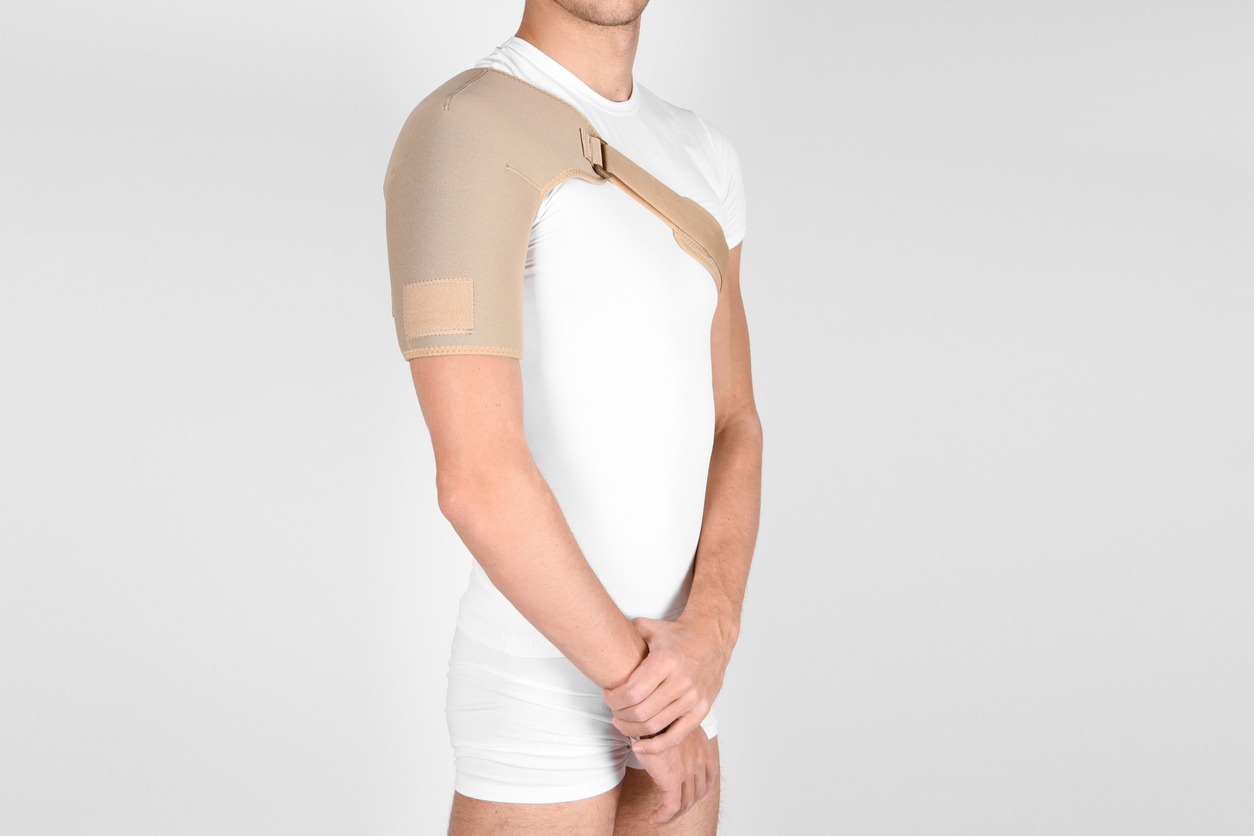Bursitis is a condition that affects the small, fluid-filled sacs called bursae, which cushion the bones, tendons, and muscles near the joints. When it becomes inflamed, it causes bursitis, which is painful. Shoulder bursitis is the most common type, and a lot of people who have these conditions also have shoulder tendinitis. These conditions cause pain and can affect mobility.
In the shoulder, the subacromial bursae cushion is affected, which is the region between the shoulder blade’s highest point, the acromion, and the rotator cuff tendons. This part enables the tendons and bones to glide without friction when you move and lift your arms. However, overuse and injuries can cause fluid to collect in the bursae, which causes bursitis. Painful swelling may come either suddenly or gradually. Doctors may also call the condition subacromial bursitis or rotator cuff tendinitis.[1]
Since the different soft tissues of the shoulder work in an interdependent manner, when one part gets damaged by bursitis, others can possibly be affected too. In turn, this condition can be debilitating. But when it is addressed properly, you can most certainly treat it. If you or a loved one is suffering from bursitis of the shoulder and you need help, you’re in the right place. In this post, we are giving you a guide on the different ways to treat the bursitis of the shoulder.
What are the Different Types of Shoulder Bursitis?
Before we go to the treatments, let us first learn about the various types of shoulder bursitis. There are different types of bursitis of the shoulder. Below are some of them:
Chronic Shoulder Bursitis
Repeat injuries or repeated incidents of acute bursitis can cause chronic shoulder bursitis. This is the most common type of shoulder bursitis. When you have this, you may experience periods without symptoms and then have symptom flare-ups that may last for several months. Over time, the inflammation can cause arm and shoulder weakness. A lot of people learn to adapt to the pain. However, it may also lead to other regional pain, such as other parts of the shoulder, neck, or elbow.[1]
Acute Shoulder Bursitis / Traumatic Bursitis
This type of shoulder bursitis comes on suddenly. It often results from an accident or injury. When you have acute shoulder bursitis, touching or moving your shoulder causes pain.[1]
Infectious Shoulder Bursitis (Septic)
This is a rare case when bacterial infections like staph infections cause infectious or septic shoulder bursitis. This may make the shoulder appear red or purple and feel warm to the touch. Also, when you have infectious shoulder bursitis, you may have a fever and feel sick. It also causes severe shoulder pain.[1]
What Causes Bursitis?
Bursitis commonly affects the shoulder, but it can also develop in any joint. Most of the time, shoulder bursitis is the result of overuse or repetitive shoulder movements. Overhead activities may increase friction between bones and tissues. Ongoing friction may inflame and irritate the bursae. Therefore, when fluid builds up in the bursa sacs, it leads to bursitis.[1]
Anyone can acquire shoulder bursitis, but certain professionals and athletes who usually do a lot of repetitive shoulder movements are more prone to it. Some of them include carpenters, painters, builders, and those who play softball, football, and lacrosse. In addition, people who have existing health conditions, such as arthritis, gout, diabetes, kidney disease, rheumatoid arthritis, and thyroid disease, are more prone to shoulder bursitis.[1]
What are the Symptoms of Shoulder Bursitis?
The symptoms of bursitis depend on how severe the inflammation is and the type of bursitis there is. For instance, when you have chronic bursitis, the most obvious symptom is swelling. Most patients with this type of bursitis seek medical attention as the swelling may last for a longer period and does not improve.
The area around the inflamed bursa may feel overly heated in those with infected bursitis. They may also feel a great deal of pain, tenderness, and fever. The arm may experience swelling and redness that extend up or down from the area that is actually affected. It may also make you feel very sick, tired, and feverish. Therefore, seeking medical attention when you have these symptoms is very important.[2]
Acute or traumatic bursitis of the shoulder presents with a fast onset of swelling. These cases mostly happen after a specific event. For instance, when a football player hits his elbow on hard artificial turf. The affected part may be tender and warm, but not to an excessive degree. There may also be bruising along with swelling.[2]
How is Bursitis of the Shoulder Diagnosed?
Aside from a complete medical history and physical exam, there are other tests that can be done to be able to diagnose shoulder bursitis. Some of these are listed below:
X-Ray: This is a diagnostic test that uses invisible electromagnetic energy beams to take pictures of internal tissues, organs, and bones on film.[3]
Magnetic Resonance Imaging (MRI): This is an imaging test that utilizes a combination of large magnets, radio frequencies, and a computer to create precise images of the body’s organs and structures.[3]
Ultrasound: This is an imaging test that utilizes high-frequency sound waves to view the internal organs and tissues.[3]
Aspiration: This is a procedure that involves using a thin needle to remove fluid from the swollen bursa. This way, it can be checked for infection or gout as causes of bursitis.[3]
Blood Tests: There are also certain blood tests and lab tests that may be done to confirm or rule out other conditions caused by bursitis.[3]
What are the Treatments for Bursitis of the Shoulder?
There are various ways that shoulder bursitis can be treated. The first step in treating this condition is by reducing the inflammation. One of the ways to reduce inflammation is to avoid activities or movements that may cause pain, such as reaching or stretching beyond your comfort zone. Below are the different treatments that can be done for bursitis of the shoulder:
Rest
Shoulder bursitis typically occurs due to certain repeated movements of the shoulder that may cause inflammation. Whether it be movements that are bad for the shoulder, such as throwing a baseball to simply running in a certain way, repetitive movements such as these can damage your shoulder over time.
Therefore, to make sure that the condition improves, it is necessary to stop these movements or exercises. You should spend as much time as possible with your shoulder in the resting position. Try to avoid jerking your arm around in a way that might disturb the already irritated shoulder.
Shoulder Brace
In order to make sure that you keep the shoulder in a sound resting position, a shoulder brace is often recommended. A good shoulder brace is important for keeping your shoulder stable and compressed. By supporting your shoulder, you can avoid irregular movements and tweaks that can worsen your condition. The compression that the shoulder brace provides improves blood flow which can aid in helping your shoulder repair.
Below are some examples of shoulder braces that can be used while treating shoulder bursitis:
- Vive Shoulder Brace: This shoulder brace can provide soothing and customizable compression for those who have shoulder bursitis. It can help minimize unsafe movements, preventing re-injury of the shoulder for faster recovery. It has a reversible low-profile design, and it is suitable for both men and women. Its fit can be adjusted as needed. It is made of breathable neoprene blend material, making it comfortable to wear.
- Arctic Flex Shoulder Ice Pack Brace: This is a pain-relieving shoulder support brace that also provides cold compression. It is great for shoulder bursitis, along with other conditions like sprains and strains. It includes an Arctic Flex gel pack that remains flexible when frozen to contour the shoulder comfortably and provide soothing relief.
Anti-Inflammatory Cream
Bursitis is caused by inflammation of the bursa. The bursa is a fluid-filled sack that acts as a cushion between joints. When it becomes inflamed, you experience the pain and immobility that comes with bursitis. Using anti-inflammatory creams is thus one of the most effective ways to treat bursitis.
Below you can find some of the best creams that you can use to treat bursitis:
- Workvie Pain Relief Therapy: This cream is a great quality anti-inflammatory that is a fantastic treatment for bursitis of the shoulder. It contains powerful key ingredients that can aid in the healing process. MSM and chondroitin are powerful ingredients in the formula that are effective in reducing inflammation and also repairing damaged tendons and ligaments.
- Penetrex Joint & Muscle Therapy: This cream is a powerful pain reliever and anti-inflammatory that is also a great treatment for bursitis of the shoulder. It is unique in the sense that you can use it not only for bursitis but for any kind of inflammation of the joints, arthritis, muscle pains, or soreness. It also has something of a “self-sustaining” pain relief effect. According to users, after the first few times using the formula, it is not necessary to use it as frequently after. It’s almost as if the pain relief stays in your system after the first few uses.
- Biofreeze: Biofreeze is an excellent formula for those who have shoulder bursitis but are still active. By using cold therapy, Biofreeze essentially acts as an icepack in the form of a gel. Once you rub the formula into the shoulder, it gives off a chilling sensation that not only numbs the pain but also reduces the inflammation of bursitis.
Exercises
Various shoulder exercises and stretches can help to reduce tension in the shoulders. As a result, relieving tension can help to reduce inflammation and promote blood flow. Practicing these exercises a few times a day is a great treatment for bursitis of the shoulder if they are performed regularly in a controlled manner. However, talk to your doctor before performing these exercises to be sure that your bursitis is mild enough for stretching and exercise.
Listed below are three of the most basic exercises you can perform:
Shoulder Shrugs
Shoulder shrugging is one of the most basic stretches for bursitis. Start by standing straight up or sitting up, looking ahead with your arms straight at your sides. Slowly shrug your shoulders as if you are trying to touch your earlobes with the tops of your shoulders. Once your shoulders are at their peak, hold the position for three seconds. From there, slowly bring your arms back down. Be sure to feel the stretch at the bottom position.
If the pain in the shoulders is less severe, you can add a little variation to this exercise. After you raise your shoulders, you can then focus on rolling your shoulders back as you move back to the resting position.
Shoulder Blade Squeeze
Again, start by standing or sitting up, looking ahead with your arms straight at your sides. Proceed to pull your shoulders back. Try to imagine squeezing a tennis ball between your shoulder blades. Make sure that you don’t elevate your shoulders but keep them at a steady level. Squeeze your shoulder blades together for three seconds and then slowly release them back to the starting position.
Posterior Stretch
Again, start by standing or sitting up, looking ahead with your arms straight at your sides. Bring your straight arm across your body. With your other hand, gently pull your arm across your chest. Concentrate on getting a stretch across the back of the shoulder blade. Hold the stretch for three seconds and then slowly release the arm.
You may repeat these exercises multiple times in one session, and you can practice these exercises two to three times a day.
Surgical Treatment
There are times when surgery is needed to treat shoulder bursitis. It can be done by using a small incision with a special, minimally invasive probe referred to as an arthroscope. The inflamed bursa and some of the bone and any spurs are removed during the surgery to create a larger space for the rotator cuff tendons.[3]
How to Prevent Shoulder Bursitis
As a lot of people always say, prevention is better than cure. However, when it comes to shoulder bursitis, there is not much you can do to prevent one that is associated with an infection or an injury, such as falling or being in a car injury. But there are things that you can do to prevent one of the most common causes of shoulder bursitis, which is overuse.
For instance, if your job requires repetitive use of your shoulders, it is important that you take frequent breaks to allow your joints some time to rest between activities. Also, if you are starting a new activity, make sure that you work into it gradually to allow your shoulder some time to adjust and build strength.[4]
Acquiring bursitis is common among athletes, particularly in sports that require throwing, swinging, or using the arms over the head. To reduce your risk of bursitis in these activities, making sure to warm up before playing is important. This way, your shoulder would be warm and flexible when you play.
If ever you feel pain for the first time, rest your shoulders and apply ice. If the symptoms continue or get worse, it is important to call and book an appointment with your doctor right away. Early management is the best way to prevent shoulder bursitis from getting worse.[4]
Conclusion
Bursitis of the shoulder is indeed painful, and it can prevent you from doing your regular tasks, particularly if it includes lifting objects. But the great thing is that there are various treatments that you can lean on in order to treat shoulder bursitis. Therefore, the moment that you feel pain in your shoulder, you need to make sure that you see your doctor immediately to get the proper treatment that you need for a fast recovery. We hope this post helped you learn more about the treatments for the bursitis of the shoulder.
References
[1] Cleveland Clinic, E. (2021, May 7). Bursitis in shoulder: What it is, treatments, symptoms. Cleveland Clinic. Retrieved November 8, 2022, from https://my.clevelandclinic.org/health/diseases/21530-bursitis-in-shoulder
[2] Johns Hopkins Medicine, E. (2021, August 8). Shoulder Bursitis. Shoulder Bursitis | Johns Hopkins Medicine. Retrieved November 8, 2022, from https://www.hopkinsmedicine.org/health/conditions-and-diseases/shoulder-bursitis
[3] Cedars Sinai, E. (2022). Bursitis of the Shoulder. Cedars. Retrieved November 8, 2022, from https://www.cedars-sinai.org/health-library/diseases-and-conditions/b/bursitis-of-the-shoulder.html
[4] Next Step Orthopedics, E. (n.d.). How to prevent shoulder bursitis. How to Prevent Shoulder Bursitis: Next Step Orthopedics: Orthopedic Surgeons. Retrieved November 8, 2022, from https://www.nextsteportho.net/blog/how-to-prevent-shoulder-bursitis











